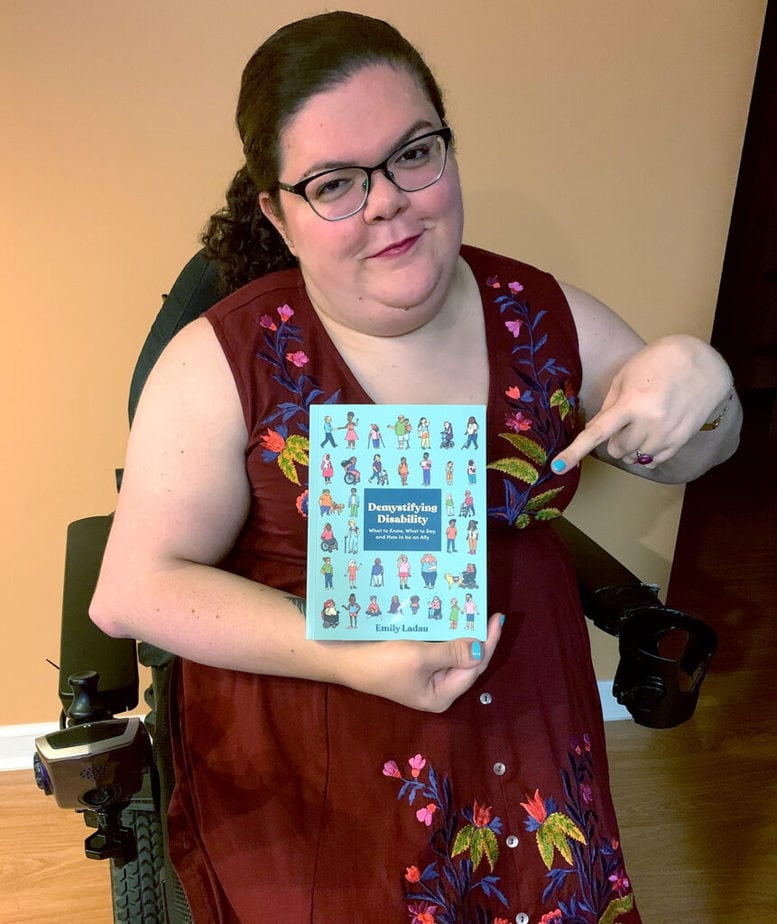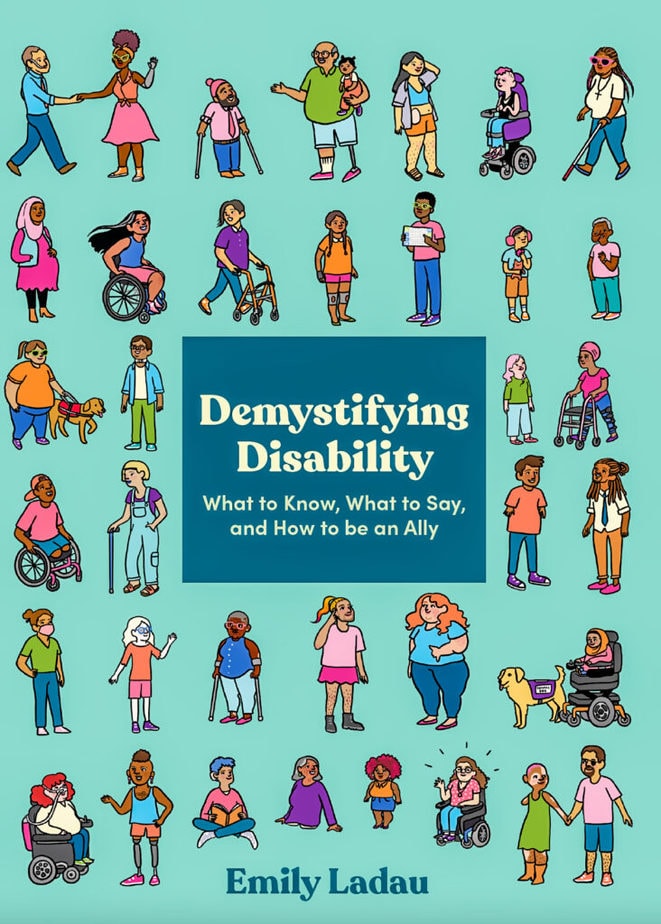
Rooted in Rights Editor Emily Ladau has gifted the disability community with a short, simple book that packs in just about everything we wish our friends and families understood about disability but don’t know how to tell them.
In less than 200 pages, Ladau demonstrates intersectionality and a cross-disability approach, breaks down all the various models we’re subjected to and even presents an updated etiquette guide. She enlists quotes from fellow thinkers with disabilities, such as doctoral student D’Arcee Neal, a Black wheelchair user with cerebral palsy. “Being part of one marginalized community doesn’t absolve you from understanding discrimination from marginalized people whose experiences are different from your own,” he says in her book. She juxtaposes heady quotes like Neal’s with down-to-earth language in the etiquette chapter that spells it out more simply: “Follow the Golden Rule and treat others as you’d like to be treated. But, also, try not to make assumptions about what that may mean.”
Although honest, Ladau’s book is especially kind. She understands that we don’t know all there is to know about each other, where we’re from, what abilities we may or may not have or the life experiences that brought us to her book. It’s written for the nondisabled student taking a class and the jaded old activist who’ll go to the mat for the correct (although slightly outdated) person-first language formula.
Read Ladau’s book if you want a primer on the various disability rights movements. Read it if you are interested in our combined history or how language is evolving around all types of disabilities. And give it to a friend or family member or prospective personal assistants to read if you’d like them to understand, gently, where you’re coming from.
The following excerpt from chapter two of Ladau’s book deals with what it means to identify as disabled. It’s an insider’s look at who we are, how we see ourselves and how we’d like to be seen.
— Josie Byzek
Demystifying Disability

Excerpted from Demystifying Disability: What to Know, What to Say, and How to Be an Ally by Emily Ladau with permission from Ten Speed Press, an imprint of Penguin Random House.
Chapter 2: Understanding Disability as Part of a Whole Person
My relationship status with disability is complicated. On one hand, my disability is an integral facet of my being. It is completely intertwined with how I think and how I move. I consider it to be an identity — in many ways, my defining identity, although I don’t want to be solely defined by it. Confusing, I know. I take pride in being disabled, and it’s brought me to a whole culture and community that I love. But on the other hand, it’s not always sunshine and roses. I struggle with physical pain every day. I feel the emotional toll from lack of acceptance, sometimes from others, sometimes within myself. But I am disabled. It’s part of me.
Here’s some food for thought: Disability is the only identity that anyone can suddenly take on at any time. Don’t worry, though! That’s not a threat. Disabled people are actually pretty cool, in my humble opinion. Disability is deeply personal and means different things to different people. Some people consider disability to be an identity. Some consider it part of who they are, but not an identity. And some who technically have disabilities choose not to identify as disabled at all. This choice is based on any number of factors and is totally up to each individual person.
Let’s think of disability identity as a pizza. The crust is the foundation of who you are — your actual being. While every pizza has a crust, it’s the toppings that make each individual pizza what it is. There can be infinite combinations of toppings. And even though millions of pizzas are made with the same toppings, no two slices are exactly alike. Having or not having a disability might seem like the most straightforward of the factors that influence what disability means to a person, but it’s actually not quite that simple. Not only does everything on the following list influence what “disability” means to someone, but each factor also determines whether a person chooses to identify as having a disability — or reveals their disability at all. What toppings might be on a person’s metaphorical pizza?
Nothing About Us Without Us
Many in the disability community use the slogan Nothing about us without us as a bold reminder of the fact that we’re the ones who must be in charge of every aspect of our lives. All too often, people with disabilities are relegated to the sidelines in conversations about issues that directly affect us — everything from individual circumstances to major policy decisions. I’d say this is due to an assumption that we can’t communicate and advocate for ourselves, but it often goes beyond that. In far too many situations, it doesn’t seem to occur to nondisabled people that disabled people can and do have our own thoughts, viewpoints and opinions. Journalists interview parents and “specialists” about us instead of coming directly to us. Doctors and teachers talk to caregivers about us instead of talking to us. Policymakers consult nondisabled “experts” about us instead of consulting us. You get the idea. But, as always, disabled people are the experts on our own lives. So please, don’t speak for us, about us, or over us. Speak to us and with us.
In the same vein, many nondisabled people deem themselves advocates “for” the disability community. Believe me, I’m all about the power of advocacy, but it’s absolutely crucial to make sure that people with disabilities are leading the charge in any and all efforts. Advocate alongside us, rather than on our behalf. Stand (or sit!) in solidarity with us, rather than moving ahead of us.
Pass the Microphone
If you are in a position of privilege, rather than using that position to amplify your own voice, ask yourself whose perspectives are missing from the conversation. Then lift up and amplify the perspectives of those people who should be centered instead. This isn’t necessarily just about keeping quiet and listening, though that’s always a crucial part. It’s often also about actively redirecting people who may be overstepping or who are ignoring the perspectives of disabled people entirely. It’s about ensuring that disabled people are respectfully given the platforms, opportunities and space to make our messages known.
We need to remember that passing the mic isn’t something that only nondisabled people need to do. Disabled people aren’t off the hook. All of us must recognize the ways in which we are both marginalized and privileged, and to know when to step up and when to step back. I asked author and artist Naomi Ortiz — whose poignant work focuses on Disability Justice, intersectionality, and self-care for activists — what we all need to understand about passing the mic. “[It] is not a one-time thing,” she said. “It’s a series of choices to build relationships, learn together, disagree without silencing the other. It’s about building up our capacity to honor difference and appreciate the messiness.”
Support New MobilityWait! Before you wander off to other parts of the internet, please consider supporting New Mobility. For more than three decades, New Mobility has published groundbreaking content for active wheelchair users. We share practical advice from wheelchair users across the country, review life-changing technology and demand equity in healthcare, travel and all facets of life. But none of this is cheap, easy or profitable. Your support helps us give wheelchair users the resources to build a fulfilling life. |


What outlet does Ms. Ladau recommend we purchase the book? Very excited to order it!